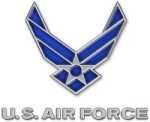All Engines Used Alternative Jet Fuel Blends
The Air Force's ongoing alternative fuels certification efforts
took another step forward late last month when a C-17 Globemaster
III from Edwards Air Force Base, CA flew on all engines using jet
fuel blended with a combination of traditional petroleum-based
fuel, or JP-8, biofuel derived in part from animal fat, and
synthetic fuel derived from coal.

The 418th Flight Test Squadron here conducted the flight tests
August 23rd to 27th. The flight was a first for any Department of
Defense aircraft where a 50 percent mix of JP-8 was blended with 25
percent renewable biofuel and 25 percent fuel derived from the
Fischer-Tropsch process, which is essentially liquified coal or
natural gas. It was also the first time an aircraft from Edwards
Air Force Base had used fuel derived from beef tallow, which is
essentially waste animal fat.
"The C-17 fleet is the biggest Air Force consumer of jet fuel
annually," said Lt. Gen. Mark D. Shackelford the military deputy to
the assistant secretary of the Air Force for acquisition. "This is
a big step forward in achieving the Air Force's energy goal of
increasing the available supply of fuel by acquiring half of the
Air Force's domestic jet fuel requirement from domestically
derived, environmentally friendly alternative sources by 2016."
For several years, the Air Force been looking at alternate
sources of fuel to support their operations, said James Holther, a
418th FLTS project engineer for biofuel testing. "The first thing
the Air Force did was look at Fischer-Tropsch fuels that use
natural gas or coal as the feedstock, and this is just a
continuation of that ongoing effort. The fuel we're testing this
time around is a biofuel manufactured with biomass as the
feedstock," he said.
The hydro-treated renewable jet fuel, or HRJ, used by the C-17
contains biomass that can be made from either animal fats or plant
extracts such as camelina, a weed-like plant not used for food. The
HRJ is blended with regular JP-8 jet fuel for the testing to gather
data to support Air Force transport aircraft certification on
alternative fuels from various feedstocks.
The Air Force Fuels Certification Office at Wright-Patterson Air
Force Base, Ohio, has certified over 85% of all Air Force aircraft
to use Fischer-Tropsch derived fuels, and is now focusing efforts
on certifying aircraft to fly on HRJ biofuel blends. "When the
certification effort is completed, it won't matter what feed stock
or process was used to make the fuel, we will simply call it
JP-8,'" said Jeff Braun, the director of the Air Force Fuel
Certification Office.
Braun said his office is responsible for testing and managing
certification of "drop-in" alternative fuel blends that will
require absolutely no modification to aircraft or ground equipment.
It also would necessarily provide the desired performance and burn
as clean or cleaner than current JP-8, as demonstrated during the
ground engine emission evaluation conducted as part of the C-17
test program. "We want maintainers, aircrews and fuels handlers to
be able to say they can perceive absolutely no difference between
traditional JP-8 and the alternative blends," he said.

The testing process featured the C-17 flying with different
combinations of HRJ and JP-8. The testing required the C-17 to
perform several maneuvers at different altitudes such as
decelerating and then accelerating, to see how the plane responds
with the HRJ mixed in, Holther added.
The 418th FLTS took precautionary measures to build up to the
final test day. "On Monday we had JP-8 in three engines, and one
engine had a blend of 50-50 biofuel and the JP-8," Holther said.
"It's part of a safety build-up. We'll build up to putting the fuel
in all four engines by verifying the performance differences are
insignificant between the blended fuel engine and the regular fuel
engines." On August 24th, the test team expanded the evaluation by
utilizing the HRJ blended fuel in all four engines, flying the
aircraft on 50 percent biofuel. A successful test is signified when
the C-17 performs with little or no difference between the blended
fuel and JP-8. The flight testing culminated August 27th with the
C-17 using a blend of HRJ: JP-8 and a Fischer-Tropsch fuel mixture:
50 percent JP-8, 25 percent HRJ and 25 percent Fischer-Tropsch.
The potential use of alternative fuels could provide the Air
Force with more options and greater flexibility in the future.
"This is an opportunity for us to investigate the possible use of
clean, renewable fuel sources," said Lt. Col. Clifton Janney, the
418th FLTS commander. "If successful, it can broaden the spectrum
of fuels that we can use Air Force-wide."
Successful testing of the HRJ with the C-17 will be used by the
AFCO office to support certification of the biofuel in military and
commercial transport aircraft, Holther said. "This test we are
doing with the C-17 and biofuel is considered a 'pathfinder'
effort, which means similar aircraft, like the C-5 (Galaxy), might
be qualified to use this fuel based on the test results we get with
the C-17."
Braun said lessons learned from certifying individual airframes
on Fischer-Tropsch fuels has been applied to the HRJ alternative
fuel certification process, which will enable accelerated
certification using pathfinder aircraft, then certifying other
systems by similarity. The F-22 Raptor is the planned pathfinder
for certifying the fighter fleet and the RQ-4 Global Hawk is being
explored for platforms which operate at high-altitude.
 Airbus Racer Helicopter Demonstrator First Flight Part of Clean Sky 2 Initiative
Airbus Racer Helicopter Demonstrator First Flight Part of Clean Sky 2 Initiative Diamond's Electric DA40 Finds Fans at Dübendorf
Diamond's Electric DA40 Finds Fans at Dübendorf ANN's Daily Aero-Term (04.23.24): Line Up And Wait (LUAW)
ANN's Daily Aero-Term (04.23.24): Line Up And Wait (LUAW) NTSB Final Report: Extra Flugzeugbau GMBH EA300/L
NTSB Final Report: Extra Flugzeugbau GMBH EA300/L Classic Aero-TV: 'Never Give Up' - Advice From Two of FedEx's Female Captains
Classic Aero-TV: 'Never Give Up' - Advice From Two of FedEx's Female Captains




